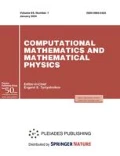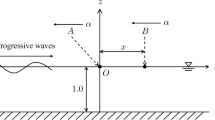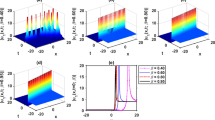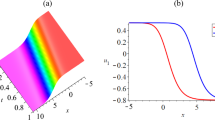Abstract
A variational approach for solving the boundary value problem of computing ray trajectories and fronts of ocean waves is presented. The solution method is based on Fermat’s principle (of stationary time). A distinctive feature of the proposed approach is that the Fermat functional is optimized directly without solving the Euler–Lagrange equation; moreover, the locations of the wave source and receiver are fixed. Multipath propagation in the boundary value problem is addressed by finding various types of stationary points of the Fermat functional. The technique is numerically tested by applying the method of bicharacteristics with the use of analytical seabed models. The advantages of the variational approach and the prospects of its further development as applied to ocean wave computation are described. The relations between various types of stationary points of the travel time functional, caustics, and foci are discussed.






Similar content being viewed by others
REFERENCES
A. G. Marchuk, L. B. Chubarov, and Yu. I. Shokin, Numerical Modeling of Tsunamis (Nauka, Moscow, 1983) [in Russian].
E. N. Pelinovskii, Hydrodynamics of Tsunami Waves (Inst. Prikl. Fiz. Ross. Akad. Nauk, N. Novgorod, 1996) [in Russian].
M. V. Berry, “Focused tsunami waves,” Proc. R. Soc. A: Math. Phys. Eng. Sci. 463 (2087), 3055–3071 (2007).
K. Satake, “Effects of bathymetry on tsunami propagation: Application of ray tracing to tsunamis,” Pure Appl. Geophys. 126 (1), 27–36 (1988).
S. N. Ward, “Landslide tsunami,” J. Geophys. Res. Solid Earth B 106 (6), 11201–11215 (2001).
S. Y. Dobrokhotov, S. Y. Sekerzh-Zenkovich, B. Tirozzi, and T. Y. Tudorovskii, “Description of tsunami propagation based on the Maslov canonical operator,” Dokl. Math. 74 (1), 592–596 (2006).
S. Y. Dobrokhotov, A. I. Shafarevich, and B. Tirozzi, “Localized wave and vortical solutions to linear hyperbolic systems and their application to linear shallow water equations,"* Russ. J. Math. Phys. 15 (2), 192–221 (2008).
S. Y. Dobrokhotov and V. E. Nazaikinskii, “Punctured Lagrangian manifolds and asymptotic solutions of the linear water wave equations with localized initial conditions,” Math. Notes 101 (5), 1053–1060 (2017).
N. N. Kalitkin, Numerical Methods, 2nd ed. (BKhV-Peterburg, St. Petersburg, 2011) [in Russian].
J. Um and C. Thurber, “A fast algorithm for two-point seismic ray tracing,” Bull. Seismol. Soc. Am. 77 (3), 972–986 (1987).
T. J. Moser, G. Nolet, and R. Snieder, “Ray bending revisited,” Bull. Seismol. Soc. Am. 82 (1), 259–288 (1992).
C. J. Coleman, “Point-to-point ionospheric ray tracing by a direct variational method,” Radio Sci. 46 (5), 1–7 (2011).
A. V. Benzik, “Prediction of trajectory characteristics of decametric waves propagation on the basis of Fermat’s principle,” Tekh. Radiosvyazi, No. 1, 32–41 (2014).
G. Mills and H. Jónsson, “Quantum and thermal effects in H2 dissociative adsorption: Evaluation of free energy barriers in multidimensional quantum systems,” Phys. Rev. Lett. 72 (7), 1124 (1994).
H. Jónsson, G. Mills, and K. W. Jacobsen, “Nudged elastic band method for finding minimum energy paths of transitions,” in Classical and Quantum Dynamics in Condensed Phase Simulations (World Scientific, Singapore, 1998), pp. 385–404.
G. Henkelman and H. Jónsson, “A dimer method for finding saddle points on high dimensional potential surfaces using only first derivatives,” J. Chem. Phys. 111 (15), 7010–7022 (1999).
P. F. Bessarab, V. M. Uzdin, and H. Jónsson, “Size and shape dependence of thermal spin transitions in nanoislands,” Phys. Rev. Lett. 110 (2), 020604 (2013).
P. F. Bessarab, V. M. Uzdin, and H. Jónsson, “Method for finding mechanism and activation energy of magnetic transitions, applied to skyrmion and antivortex annihilation,” Comput. Phys. Commun. 196, 335–347 (2015).
I. A. Nosikov, M. V. Klimenko, P. F. Bessarab, and G. A. Zhbankov, “Application of the nudged elastic band method to the point-to-point radio wave ray tracing in IRI modeled ionosphere,” Adv. Space Res. 60 (2), 491–497 (2017).
I. A. Nosikov, M. V. Klimenko, G. A. Zhbankov, A. V. Podlesnyi, V. A. Ivanova, and P. F. Bessarab, “Generalized force approach to point-to-point ionospheric ray tracing and systematic identification of high and low rays,” IEEE Trans. Antennas Propag. 68 (1), 455–467 (2020).
S. Kabanikhin, A. Hasanov, I. Marinin, O. Krivorotko, and D. Khidasheli, “A variational approach to reconstruction of an initial tsunami source perturbation,” Appl. Numer. Math. 83, 22–37 (2014).
I. A. Nosikov, P. F. Bessarab, and M. V. Klimenko, “Method of transverse displacements formulation for calculating the HF radio wave propagation paths: Statement of the problem and preliminary results,” Radiophys. Quantum Electron. 59, 1–12 (2016).
D. M. Einarsdóttir, A. Arnaldsson, F. Óskarsson, and H. Jónsson, “Path optimization with application to tunneling,” International Workshop on Applied Parallel Computing (Springer, Berlin, 2010), pp. 45–55.
V. Ásgeirsson, A. Arnaldsson, and H. Jónsson, “Efficient evaluation of atom tunneling combined with electronic structure calculations,” J. Chem. Phys. 148 (10), 102334 (2018).
P. M. Gutiérrez, C. Argáez, and H. Jónsson, “Improved minimum mode following method for finding first order saddle points,” J. Chem. Theory Comput. 13 (1), 125–134 (2017).
H. C. Andersen, “Molecular dynamics simulations at constant pressure and/or temperature,” J. Chem. Phys. 72 (4), 2384–2393 (1980).
ACKNOWLEDGMENTS
We are grateful to P.F. Bessarab for his invaluable contribution to the development of the variational approach and fruitful long-term cooperation.
Funding
Nosikov’s work concerning the implementation of the model of ray trajectory computation for ocean waves based on the variational principle was supported by a grant from the Russian President for Young Scientists, project no. MK-2584.2019.5. Part of Tolchennikov and Dobrokhotov’s work involving computations relying on the method of bicharacteristics was performed within the state assignment, registration no. AAAA-A17-117021310377-1. Klimenko’s research concerning the relationship of high-order saddle points with foci and caustics and their determination by applying global optimization techniques and the generalized force method was supported by the Russian Science Foundation, project no. 17-77-20009.
Author information
Authors and Affiliations
Corresponding authors
Additional information
Translated by I. Ruzanova
Rights and permissions
About this article
Cite this article
Dobrokhotov, S.Y., Klimenko, M.V., Nosikov, I.A. et al. Variational Method for Computing Ray Trajectories and Fronts of Tsunami Waves Generated by a Localized Source. Comput. Math. and Math. Phys. 60, 1392–1401 (2020). https://doi.org/10.1134/S0965542520080072
Received:
Revised:
Accepted:
Published:
Issue Date:
DOI: https://doi.org/10.1134/S0965542520080072




